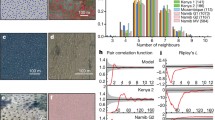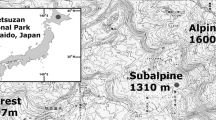Abstract
We propose a model which describes the dynamics of vast classes of terrestrial plant communities growing in arid or semi-arid regions throughout the world. On the basis of this model, we show that the vegetation stripes (tiger bush) formed by these communities result from an interplay between short-range cooperative interactions controlling plant reproduction and long-range self-inhibitory interactions originating from plant competition for environmental resources. Isotropic as well as anisotropic environmental conditions are discussed. We find that vegetation stripes tend to orient themselves in the direction parallel or perpendicular with respect to a direction of anisotropy depending on whether this anisotropy influences the interactions favouring or inhibiting plant reproduction; furthermore, we show that ground curvature is not a necessary condition for the appearance of arcuate vegetation patterns. In agreement within situ observations, we find that the width of vegetated bands increases when environmental conditions get more arid and that patterns formed of stripes oriented parallel to the direction of a slope are static, while patterns which are perpendicular to this direction exhibit an upslope motion.
Similar content being viewed by others
References
Ambouta, K. 1984. Contribution à l'édaphologie de la brousse tigrée de l'Ouest Nigérien. Thèse de Docteur-Ingénieur, Université de Nancy I.
Audry, P. and Ch. Rossetti. 1996. Is the banded pattern merely a structural expression of an instable pioneer vegetation. Communication atSALT Int. Symp: Banded vegetation patterning in arid and semi-arid environment. Ecological processes and consequences for management. Paris, France.Acta Oecologica, to appear.
Beard, J. S. 1967. A study of patterns in some West Australian Health and Mallee communities.Aust. J. Bot. 15, 131–139.
Bernd, J. 1978. The problem of vegetation stripes in semi-arid Africa.Plant. Res. and Develop. 8, 37–50.
Boaler, S. B. and C. A. H. Hodge. 1962. Vegetation stripes in Somaliland.J. Ecol. 50, 465–474.
Boaler, S. B. and C. A. H. Hodge. 1964. Observations on vegetation arcs in the northern region, Somali Republic,J. Ecol. 52, 511–544.
Clayton, W. D. 1966. Vegetation ripples near Gummi, Nigeria.J. Ecol. 54, 415–417.
Clos-Arceduc, M. 1956. Etude sur photographies aériennes d'une formation végétale sahélienne: la brousse tigrée.Bull. Inst. Afr. noire Sér. A 18, 677–684.
Clos-Arceduc, M. 1964. La géométrie des associations végétales en zone aride.Act. Conf. UNESCO: Explorations aériennes et études intégrées. Toulouse, pp. 419–421.
Cornet, A. F., J. P. Delhoume and C. Montaña. 1988. Dynamics of striped vegetation patterns and water balance in the chihuahuan desert. InDiversity and Pattern in Plant Communities, H. J. During, M. J. A. Werger and J. H. Willems (Eds), pp. 221–231. The Hague: SPB Academic Publishing.
Couteron, P. 1996. Comparison of spatial patterns of woody species in a spotted savanna and a tiger bush of Northern Yatenga (Burkina Faso, West Africa). Communication atSALT Int. Symp.: Banded vegetation patterning in arid and semi-arid environment. Ecological processes and consequences for management. Paris, France.
Cross, M. C. and P. C. Hohenberg. 1993. Pattern formation outside of equilibrium.Rev. Mod. Phys. 65, 851–1112.
Dunkerley, D. and K. Brown. 1996. Banded vegetation near Broken Hill, Australia: significance of surface roughness and soil physical properties. Communication atSALT Int. Symp.: Banded vegetation patterning in arid and semi-arid environment. Ecological processes and consequences for management. Paris, France.Catena, to appear.
Ehrman, M., S. Galle, J. Seghieri and C. Valentin. 1996. Patterning and pioneer processes of the herbaceous front in a tiger bush. Communication atSALT Int. Symp.: Banded vegetation patterning in arid and semi-arid environment. Ecological processes and consequences for management, Paris, France.
Fife, P. C. 1979.Mathematical Aspects of Reacting and Diffusing Systems. Lecture Notes in Biomathematics, Vol. 28. Berlin/New York: Springer-Verlag.
Galle, S. and J. Seghieri. 1994. Dynamics of soil water content in relation to annual vegetation: the tiger bush in the sahelian Niger.Ann. Geophys. Suppl. II 12, C443.
Gavaud, M. 1966. Etude pédologique du Niger Occidental. Editions de l'ORSTOM de Dakkar-Hann.
Glover, P. E., E. C. Trump and L. E. D. Wateridge. 1964. Termitaria and vegetation patterns on the Loita plains of Kenya.J. Ecol. 52, 367–377.
Greenwood, J. E. G. W. 1957. The development of vegetation in Somaliland Protectorate.Geogr. J. 123, 465–473.
Greig-Smith, P. 1979. Pattern in vegetation.J. Ecol. 67, 755–779.
Grove, A. T. 1957. Patterned ground in Northern Nigeria.Geogr. J. 123, 271–274.
Gunton, J. D., M. San Miguel and P. S. Sahni. 1983. The dynamics of first order transitions. InPhase Transitions and Critical Phenomena, C. Domb and J. L. Lebowitz (Eds), Vol. 8. New York: Academic Press.
Hemming, C. F. 1965. Vegetation arcs in SomalilandJ. Ecol. 53, 57–67.
Humphreys, G. S., J. Eddy, D. M. Hart, P. B. Mitchell and P. C. Fanning. 1996. Vegetation arcs and litter dams: similarities and differences. Poster atSALT Int. Symp.: Banded vegetation patterning in arid and semi-arid environment. Ecological processes and consequences for management. Paris, France.Catena, to appear.
Ives, R. L. 1946. Desert ripples.Am. J. Sci. 244, 492–501.
Langer, J. S. 1992. An introduction to the kinetics of first-order phase transitions. InSolids Far from Equilibrium, C. Godrèche (Ed), pp. 297–363. Cambridge, UK: Cambridge University Press.
Levin, S. A. and L. A. Segel. 1985. Pattern generation in space and aspect.SIAM Rev. 27, 45–67.
Litchfield, W. H. and J. A. Mabbutt. 1962. Hardpan in soils of semi-arid Western Australia.J. Soil Sci. 13, 148–159.
Mabbutt, J. A. and P. C. Fanning. 1987. Vegetation banding in arid Western Australia.J. Arid Env. 12, 41–59.
Macfadyen, W. A. 1950a. Soil and vegetation in British Somaliland.Nature 165, 121.
Macfadyen, W. A. 1950b. Vegetation patterns in the semi-desert plains of British Somaliland.Geogr. J. 116, 199–211.
Mauchamp, A., S. Rambal and J. Lepart. 1994. Simulating the dynamics of a vegetation mosaic: a spatialized functional model.Ecol. Mod. 71, 107–130.
Moloney, K. A. 1986. Wave and nonwave regeneration processes in a subalpine Abies balsamea forest.Can. J. Bot. 64, 341–349.
Montaña, C., J. Lopez-Portillo and A. Mauchamp. 1990. The response of two woody species to the conditions created by a shifting ecotone in an arid ecosystem.J. Ecol. 78, 789–798.
Montaña, C. 1992. The colonization of bare areas in two-phase mosaics of an arid ecosystem.J. Ecol. 80, 315–327.
Murray, J. D. 1993.Mathematical Biology. Biomathematics Texts, 2nd ed., Vol. 19. Berlin/New York: Springer-Verlag.
Ouedraogo, P. and M. Lepage. 1996. Termite-soil-vegetation interactions in a striped vegetation pattern, Burkina Faso. Communication atSALT Int. Symp.: Banded vegetation patterning in arid and semi-arid environment. Ecological processes and consequences for management. Paris, France.Acta Oecologica, to appear.
Ruxton, B. P. and L. Berry. 1960. The Butana grass patterns.J. Soil Sci. 11, 61–62.
Schlesinger, W. H., J. F. Reynolds, G. L. Cunningham, L. F. Huenneke, W. M. Jarrell, R. A. Virginia and W. G. Whitford. 1990. Biological feedbacks in global desertification.Science,247, 1043–1048.
Thiéry, J. M., J.-M. d'Herbès and C. Valentin. 1995. A model simulating the genesis of banded vegetation patterns in Niger.J. Ecol. 83, 497–507.
Tongway, D. J. and J. A. Ludwig. 1990. Vegetation and soil patterning in semi-arid mulga lands of Eastern Australia.Aust. J. Ecol. 15, 23–34.
Turing, A. M. 1952. The chemical basis of morphogenesis.Phil. Trans. Roy. Soc. Lond., Ser. B 237, 37–72.
Valentin, C. and J.-M. d'Herbès. 1996. The Nigerian tiger bush as natural water harvesting system. Communication atSALT Int. Symp.: Banded vegetation patterning in arid and semi-arid environment. Ecological processes and consequences for management. Paris, France.Catena, to appear.
Van Der Meulen, F. and J. W. Morris. 1979. Striped vegetation patterns in a Transvaal savanna.Geo-Eco-Trop. 3, 253–266.
Vesey-Fitzgerald, D. F. 1957. The vegetation of the Red Sea coast north of Jedda, Saudi Arabia.J. Ecol. 45, 547–562.
White, L. P. 1969. Vegetation arcs in Jordan.J. Ecol. 57, 461–464.
White, L. P. 1970.Brousses Tigrées patterns in Southern Niger.J. Ecol. 58, 549–553.
White, L. P. 1971. Vegetation stripes on sheet wash surfaces.J. Ecol. 59, 615–622.
Wickens, G. E. and F. W. Collier. 1971. Some vegetation patterns in the Republic of the Sudan.Geoderma 6, 43–59.
Wilson, J. B. and A. D. Q. Agnew. 1992. Positive feedback switches in plant communities.Adv. Ecol. Res. 23, 263–336.
Worrall, G. A. 1959. The Butana grass patterns.J. Soil Sci. 10, 34–53.
Worrall, G. A. 1960a. Patchiness in vegetation in the Northern Sudan.J. Ecol. 48, 107–115.
Worrall, G. A. 1960b. Tree patterns in the Sudan.J. Soil Sci. 11, 63–67.
Author information
Authors and Affiliations
Rights and permissions
About this article
Cite this article
Lefever, R., Lejeune, O. On the origin of tiger bush. Bltn Mathcal Biology 59, 263–294 (1997). https://doi.org/10.1007/BF02462004
Received:
Accepted:
Issue Date:
DOI: https://doi.org/10.1007/BF02462004




